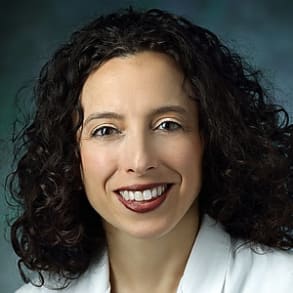Cardiologist Erin Michos offers details about a study that showed women composed only 35% of enrollment clinical trials for atrial fibrillation; 93% of the authors on the study were men.
Hi, I'm Dr Aaron Miko's I'm the Director Women's cardiovascular Health at Johns Hopkins University. And I'm pleased to talk about one of our studies that were presenting at the American Heart Association meeting that was led by Dr Safi Con and we evaluated both. The enrollment of women patients are a zwelling as Thean Vaal, Vehement of women authors among randomized clinical trials for atrial fib relation. The reason why we conducted this is women patients who have atrial fib relation. They tend to be more symptomatic, have poor quality of life and a greater risk of stroke than male patients. And despite this, women patients are underrepresented in clinical trials for atrial fib relation. And it's important that we have adequate representation of women in trials because we want to know if drugs or in therapies are both safe and efficacious in this group of population. So we did a literature review of over 30 years from 1989 to 2000 and 19 of all the randomized clinical trials for the setting of atrial fibrillation, we found 134 trials, and among these trials there was only up 35% enrollment of women patients on average and over 30 years, there really wasn't much change in enrollment and women over this timeframe. Now, of these publication of the trials, there was about 1500 authors. And among these, uh, you know, 93% of the authors or men are particularly in the key roles of first and senior author. You know, on average, there was only one woman who was an author on these papers, which again, the authorship reflects the leadership team of the tri ALS. So we then took the next step to see if there was a correlation between the number of women authors that the leaders of the trial with the percent of enrollment of women patients in the trial, we found that there was a correlation for every 1% increase in women authorship on the trial papers. There was a 19% increase in enrollment of women patients in the trials, and so are key conclusions Air. This is that women remain underrepresented both of patients in the trials and as well as underrepresented in key leadership positions in clinical trialing leadership, and so efforts to recruit and train the next generation of women scientists, women, clinical trial investigators can really hope to help improve disparities in both areas



